Aging Characteristics of Rubber Modified Bitumen Mixed with Sulfur after Terminal Blend Process
Abstract
:1. Introduction
2. Material and Methods
2.1. Materials
2.2. ATR-FTIR Test
2.3. Multiple Stress Creep and Recovery (MSCR) Test
2.4. Temperature Sweep (TS) Test
2.5. Experimental Design
3. Results and Discussion
3.1. ATR-FTIR Analysis
3.2. Jnr and R
3.2.1. Evaluation of Jnr and R before Aging
3.2.2. Evaluation of Jnr and R after Aging
3.3. G* and δ
3.3.1. Evaluation of G* and δ before Aging
3.3.2. Evaluation of G* and δ after Aging
3.4. Aging Resistance
4. Conclusions
- According to ATR-FTIR analysis, after aging, the ΔICA of the TBHB binders is less than 20TB_0S, indicating sulfur can improve the aging resistance of the TBRB binder. Additionally, TBHB can inhibit the degradation of polybutadiene compared with 20TB_0S in the RTFOT stage, and the polybutadiene degradation is the main process of TBHB binder in the RTFOT stage, while the TBHB binder is mainly desulfurized after PAV aging. Meanwhile, the increase in sulfur content in the TBHB binder can improve the desulfurization degree of the TBHB binder after PAV.
- TBRB binder contains sulfur, improving the mechanical properties and elasticity for binders, resulting in a decrease in Jnr0.1, Jnr3.2, and δ and an increase in R0.1, R3.2, and G*. This implies that the sulfur could improve the rutting resistance of the TBRB.
- R3.2 and G* of TBHB increase with the severity of aging, and the change rule of Jnr3.2 and δ is opposite to that of R3.2 and G*. Compared with TBHB binders, the decrease in Jnr3.2 of 20TB_0S (20 wt% crumb rubber, and 0 wt% sulfur) and the increase in G* of 20TB_0S is more obvious after RTFOT aging, which means that the short-term aging sensitivity of 20TB_0S is more serious than that of TBHB binders. The above results show that adding sulfur into the TBRB binder can reduce the hardening degree of the binder during aging.
- Blending sulfur into the TBRB binder caused a lower CAI after RTFOT and PAV, which indicates that TBHB has superior aging resistance. Furthermore, the reason for 20TB_0.4S having different aging resistance at different temperatures may be that 20TB_0.4S could produce a certain degree of desulfurization after PAV aging, which destroys the cross-linking structure in TBHB binders, thus affecting its aging resistance.
Author Contributions
Funding
Institutional Review Board Statement
Informed Consent Statement
Data Availability Statement
Acknowledgments
Conflicts of Interest
References
- Ruan, Y.; Davison, R.R.; Glover, C.J. Oxidation and viscosity hardening of polymer-modified asphalts. Energy Fuels 2003, 17, 991–998. [Google Scholar] [CrossRef]
- Cortizo, M.S.; Larsen, D.O.; Bianchetto, H.; Alessandrini, J.L. Effect of the thermal degradation of SBS copolymers during the ageing of modified asphalts. Polym. Degrad. Stab. 2004, 86, 275–282. [Google Scholar] [CrossRef]
- Veropalumbo, R.; Russo, F.; Oreto, C.; Buonocore, G.G.; Verdolotti, L.; Muiambo, H.; Biancardo, S.A.; Viscione, N. Chemical, Thermal, and Rheological Performance of Asphalt Binder Containing Plastic Waste. Sustainability 2021, 13, 13887. [Google Scholar] [CrossRef]
- Yildirim, Y. Polymer modified asphalt binders. Constr. Build. Mater. 2007, 21, 66–72. [Google Scholar] [CrossRef]
- Kuang, D.; Yu, J.; Feng, Z.; Li, R.; Chen, H.; Guan, Y.; Zhang, Z. Performance evaluation and preventive measures for aging of different bitumens. Constr. Build. Mater. 2014, 66, 209–213. [Google Scholar] [CrossRef]
- Chen, Z.; Zhang, H.; Duan, H. Investigation of ultraviolet radiation aging gradient in asphalt binder. Constr. Build. Mater. 2020, 246, 118501. [Google Scholar] [CrossRef]
- Zhu, C.; Zhang, H.; Xu, G.; Wu, C. Investigation of the aging behaviors of multi-dimensional nanomaterials modified different bitumens by Fourier transform infrared spectroscopy. Constr. Build. Mater. 2018, 167, 536–542. [Google Scholar] [CrossRef]
- Cao, Z.; Chen, M.; He, B.; Han, X.; Yu, J.; Xue, L. Investigation of ultraviolet aging resistance of bitumen modified by layered double hydroxides with different particle sizes. Constr. Build. Mater. 2019, 196, 166–174. [Google Scholar] [CrossRef]
- Han, L.; Zheng, M.; Wang, C. Current status and development of terminal blend tyre rubber modified asphalt. Constr. Build. Mater. 2016, 128, 399–409. [Google Scholar] [CrossRef]
- Picado-Santos, L.G.; Capitão, S.D.; Neves, J.M.C. Crumb rubber asphalt mixtures: A literature review. Constr. Build. Mater. 2020, 247, 118577. [Google Scholar] [CrossRef]
- Kim, S.; Loh, S.; Zhai, H.; Bahia, H.U. Advanced Characterization of Crumb Rubber-Modified Asphalts, Using Protocols Developed for Complex Binders. Transp. Res. Rec. 2001, 1767, 15–24. [Google Scholar] [CrossRef]
- Lee, S.J.; Akisetty, C.K.; Amirkhanian, S.N. The effect of crumb rubber modifier (CRM) on the performance properties of rubberized binders in HMA pavements. Constr. Build. Mater. 2008, 22, 1368–1376. [Google Scholar] [CrossRef]
- Akisetty, C.K.; Lee, S.J.; Amirkhanian, S.N. High temperature properties of rubberized binders containing warm asphalt additives. Constr. Build. Mater. 2009, 23, 565–573. [Google Scholar] [CrossRef]
- Hajj, E.Y.; Sebaaly, P.E.; Hitti, E.; Borroel, C. Performance Evaluation of Terminal Blend Tire Rubber HMA and WMA Mixtures-Case Studies. In Proceedings of the Asphalt Paving Technology 2011, Tampa, FL, USA, 27–30 March 2011; Volume 80, pp. 665–696. [Google Scholar]
- Chamoun, Z.; Souliman, M.I.; Hajj, E.Y.; Sebaaly, P. Evaluation of select warm mix additives with polymer and rubber modified asphalt mixtures. Can. J. Civ. Eng. 2015, 42, 377–388. [Google Scholar] [CrossRef]
- Wen, Y.; Wang, Y.; Zhao, K.; Chong, D.; Huang, W.; Hao, G.; Mo, S. The engineering, economic, and environmental performance of terminal blend rubberized asphalt binders with wax-based warm mix additives. J. Clean. Prod. 2018, 184, 985–1001. [Google Scholar] [CrossRef]
- Zhang, F.; Hu, C. The research for SBS and SBR compound modified asphalts with polyphosphoric acid and sulfur. Constr. Build. Mater. 2013, 43, 461–468. [Google Scholar] [CrossRef]
- Chen, J.S.; Huang, C.C. Fundamental characterization of SBS-modified asphalt mixed with sulfur. J. Appl. Polym. Sci. 2007, 103, 2817–2825. [Google Scholar] [CrossRef] [Green Version]
- Zhang, F.; Yu, J.; Wu, S. Effect of ageing on rheological properties of storage-stable SBS/sulfur-modified asphalts. J. Hazard. Mater. 2010, 182, 507–517. [Google Scholar] [CrossRef]
- Wen, G.; Zhang, Y.; Zhang, Y.; Sun, K.; Chen, Z. Vulcanization characteristics of asphalt/SBS blends in the presence of sulfur. J. Appl. Polym. Sci. 2001, 82, 989–996. [Google Scholar] [CrossRef]
- Wen, G.; Zhang, Y.; Zhang, Y.; Sun, K.; Fan, Y. Improved properties of SBS-modified asphalt with dynamic vulcanization. Polym. Eng. Sci. 2002, 42, 1070–1081. [Google Scholar] [CrossRef]
- Wu, S.; Pang, L.; Mo, L.; Chen, Y.; Zhu, G. Influence of aging on the evolution of structure, morphology and rheology of base and SBS modified bitumen. Constr. Build. Mater. 2009, 23, 1005–1010. [Google Scholar] [CrossRef]
- Wang, S.; Huang, W.; Lin, P. Low-Temperature and Fatigue Characteristics of Degraded Crumb Rubber–Modified Bitumen Before and After Aging. J. Mater. Civ. Eng. 2022, 34, 04021493. [Google Scholar] [CrossRef]
- Wang, S.; Huang, W.; Lin, P.; Wu, Z.; Kou, C.; Wu, B. Chemical, Physical, and Rheological Evaluation of Aging Behaviors of Terminal Blend Rubberized Asphalt Binder. J. Mater. Civ. Eng. 2021, 33, 04021302. [Google Scholar] [CrossRef]
- Wang, S.; Huang, W.; Lv, Q.; Yan, C.; Lin, P.; Zheng, M. Influence of different high viscosity modifiers on the aging behaviors of SBSMA. Constr. Build. Mater. 2020, 253, 119214. [Google Scholar] [CrossRef]
- Mansourkhaki, A.; Ameri, M.; Daryaee, D. Application of different modifiers for improvement of chemical characterization and physical-rheological parameters of reclaimed asphalt binder. Constr. Build. Mater. 2019, 203, 83–94. [Google Scholar] [CrossRef]
- Tang, N.; Huang, W.; Xiao, F. Chemical and rheological investigation of high-cured crumb rubber-modified asphalt. Constr. Build. Mater. 2016, 123, 847–854. [Google Scholar] [CrossRef]
- AASHTO M 332-14; Standard Specification for Performance-Graded Asphalt Binder Using Multiple Stress Creep Recovery (MSCR) Test. American Association of State Highway and Transportation Official: Washington, DC, USA, 2014.
- AASHTO M 320-14; Standard Specification for Performance-Graded Asphalt Binder. ASTM International (ASTM): Washington, DC, USA, 2014.
- Wang, S.; Huang, W. Investigation of aging behavior of terminal blend rubberized asphalt with SBS polymer. Constr. Build. Mater. 2021, 267, 120870. [Google Scholar] [CrossRef]
- Liu, M.; Ferry, M.A.; Davison, R.R.; Glover, C.J.; Bullin, J.A. Oxygen uptake as correlated to carbonyl growth in aged asphalts and asphalt Corbett fractions. Ind. Eng. Chem. Res. 1998, 37, 4669–4674. [Google Scholar] [CrossRef]
- Liu, M.; Lunsford, K.M.; Davison, R.R.; Glover, C.J.; Bullin, J.A. The kinetics of carbonyl formation in asphalt. AIChE J. 1996, 42, 1069–1076. [Google Scholar] [CrossRef]
- Morian, N.; Zhu, C.; Hajj, E.Y. Rheological Indexes: Phenomenological Aspects of Asphalt Binder Aging Evaluations. Transp. Res. Rec. 2015, 32–40. [Google Scholar] [CrossRef]
- Yan, C.; Lv, Q.; Zhang, A.A.; Ai, C.; Huang, W.; Ren, D. Modeling the modulus of bitumen/SBS composite at different temperatures based on kinetic models. Compos. Sci. Technol. 2021, 218, 109146. [Google Scholar] [CrossRef]
- D’Angelo, J.A. The Relationship of the MSCR Test to Rutting. Road Mater. Pavement Des. 2009, 10, 61–80. [Google Scholar] [CrossRef]
- Ābele, A.; Merijs-Meri, R.; Bērziņa, R.; Zicāns, J.; Haritonovs, V.; Ivanova, T. Effect of bio-oil on rheological and calorimetric properties of RTFOT aged bituminous compositions. Int. J. Pavement Res. Technol. 2021, 14, 537–542. [Google Scholar] [CrossRef]


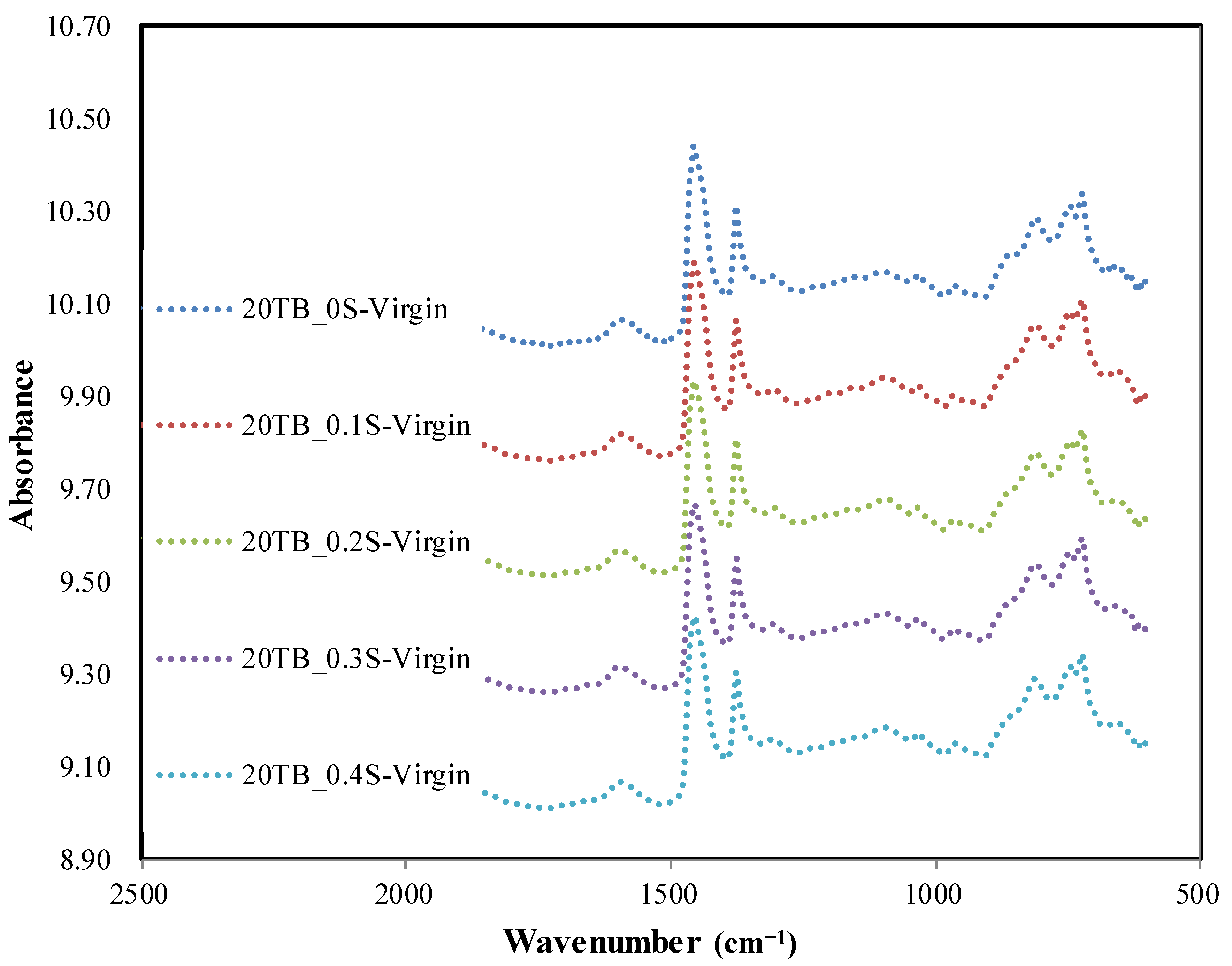
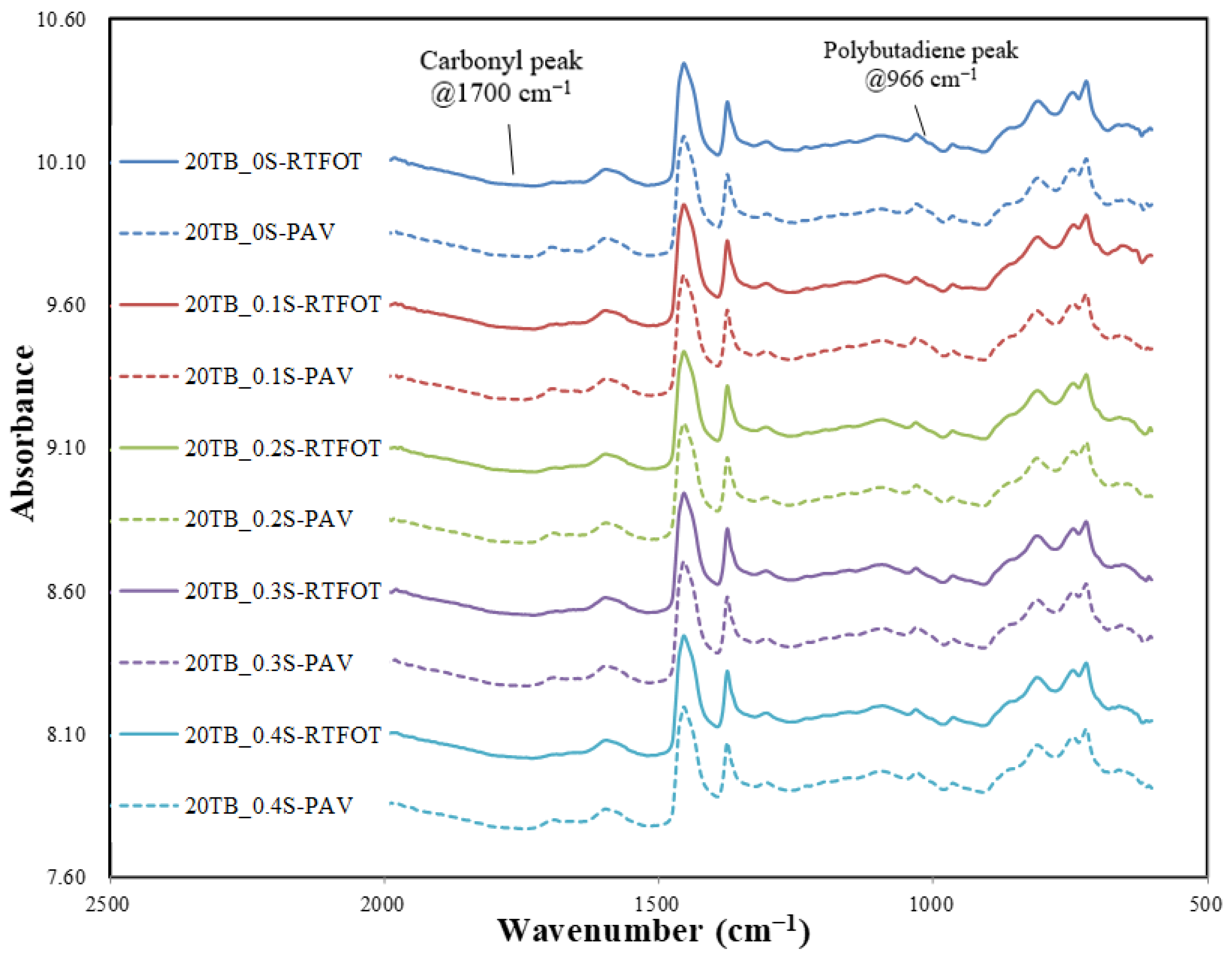

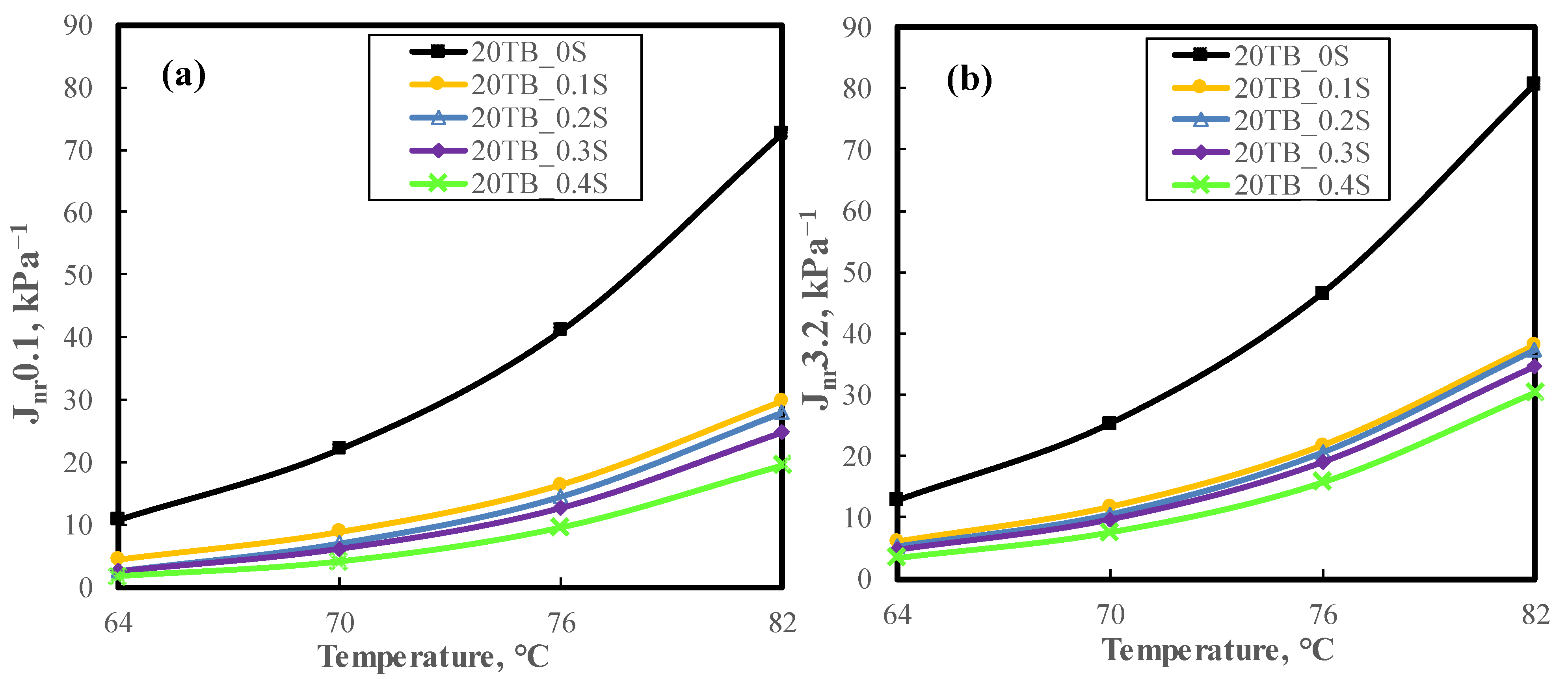
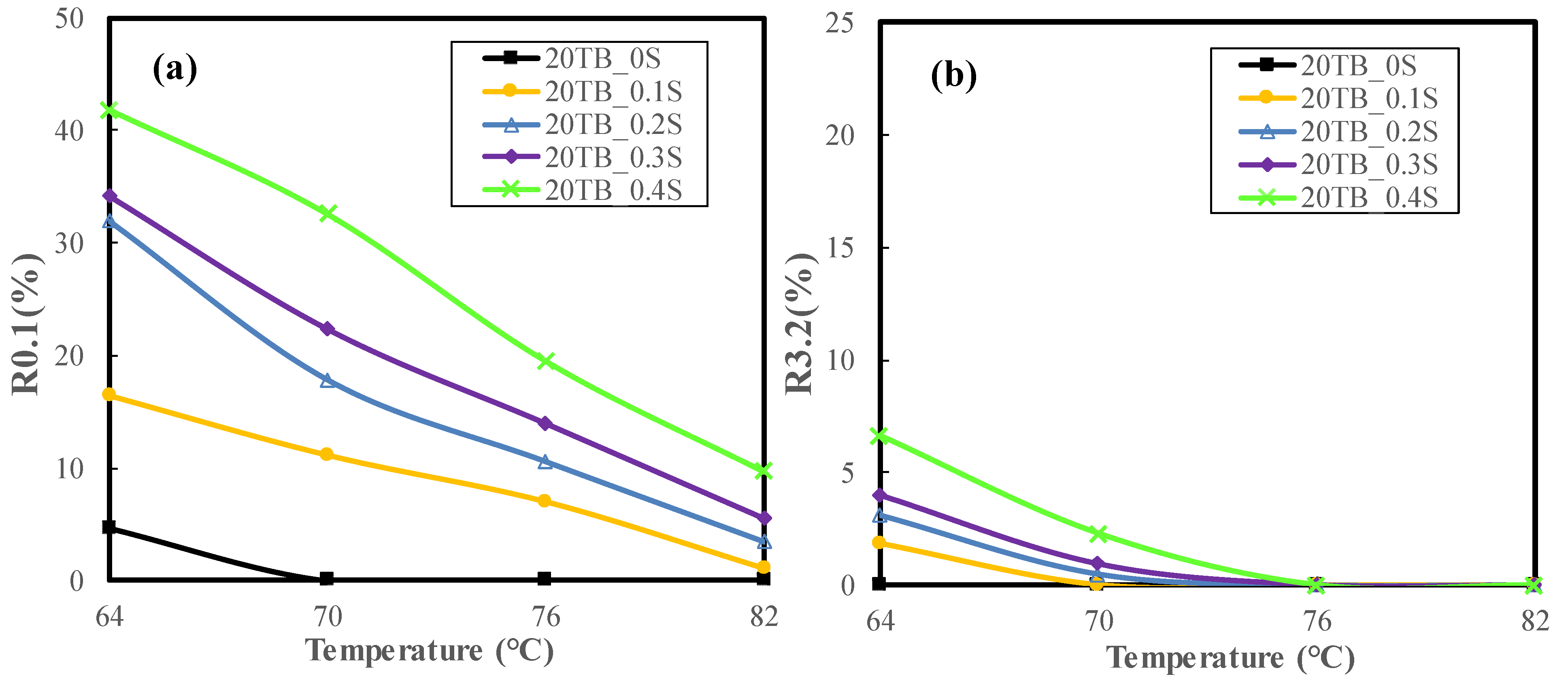
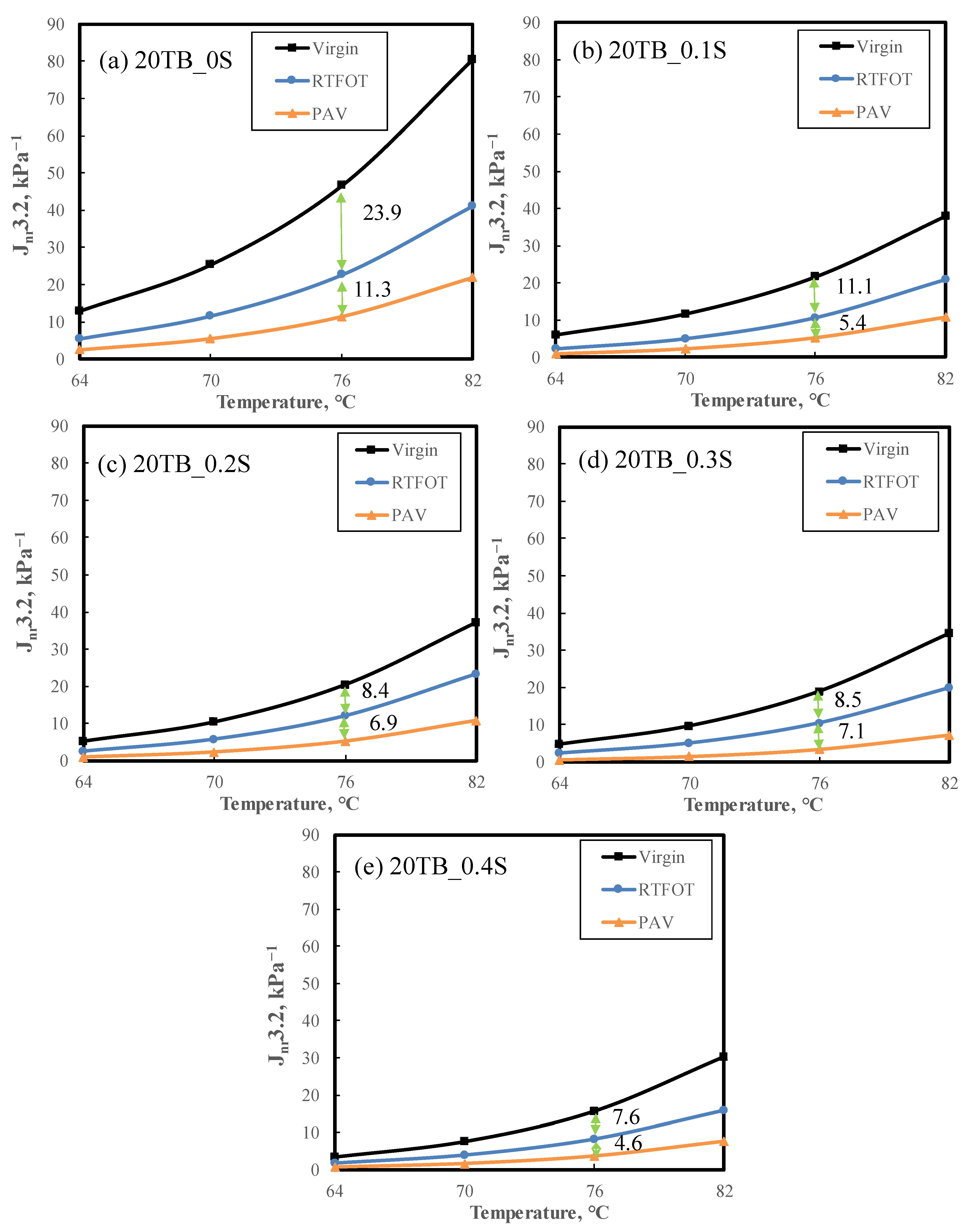
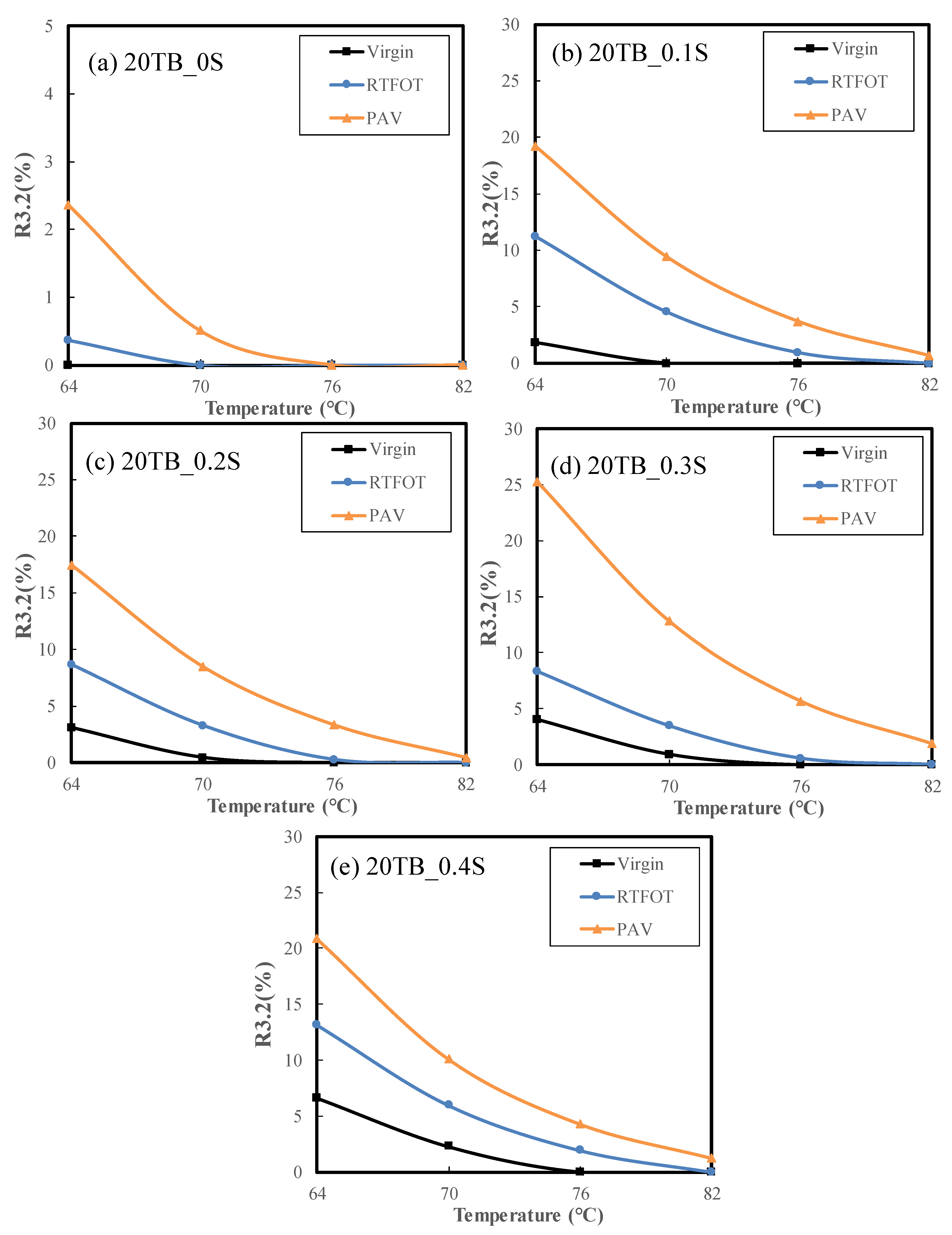
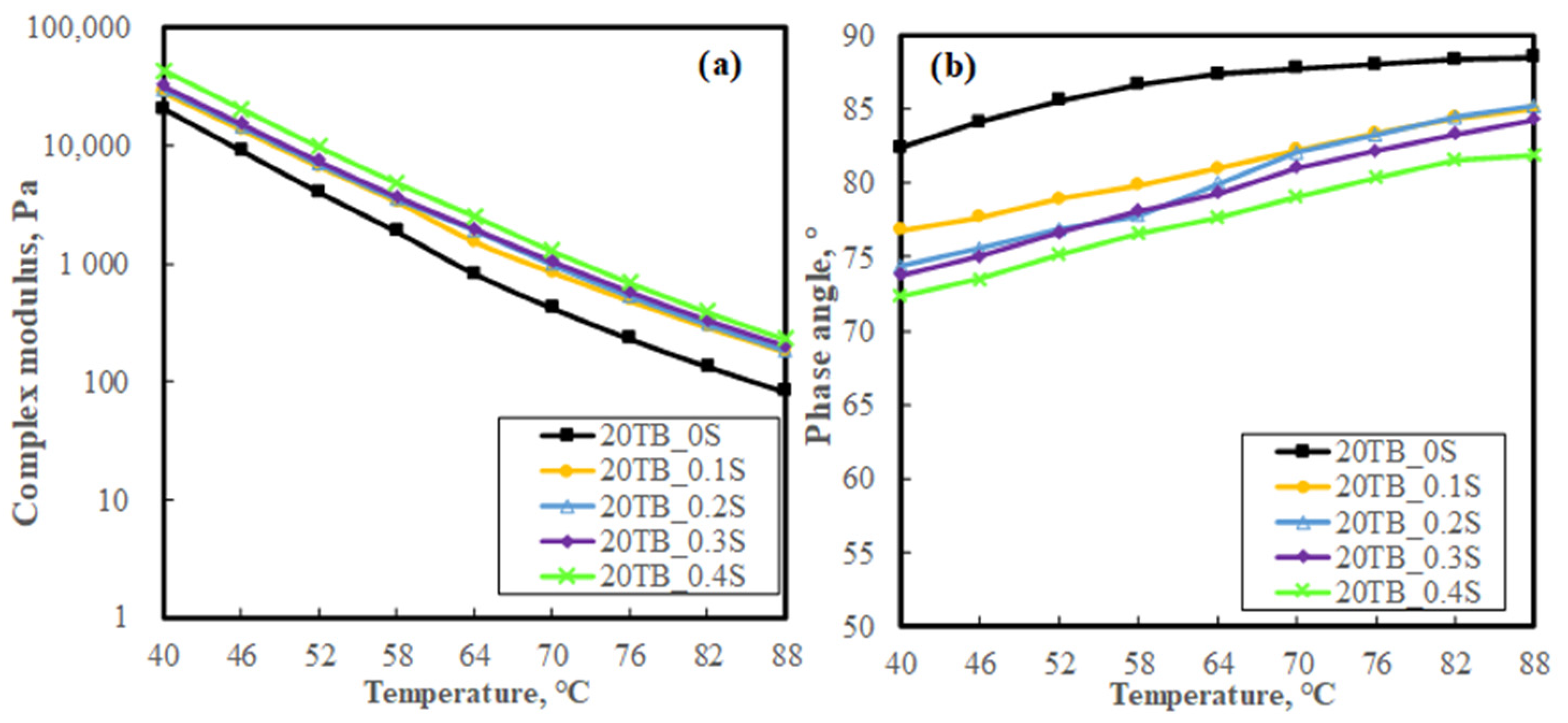
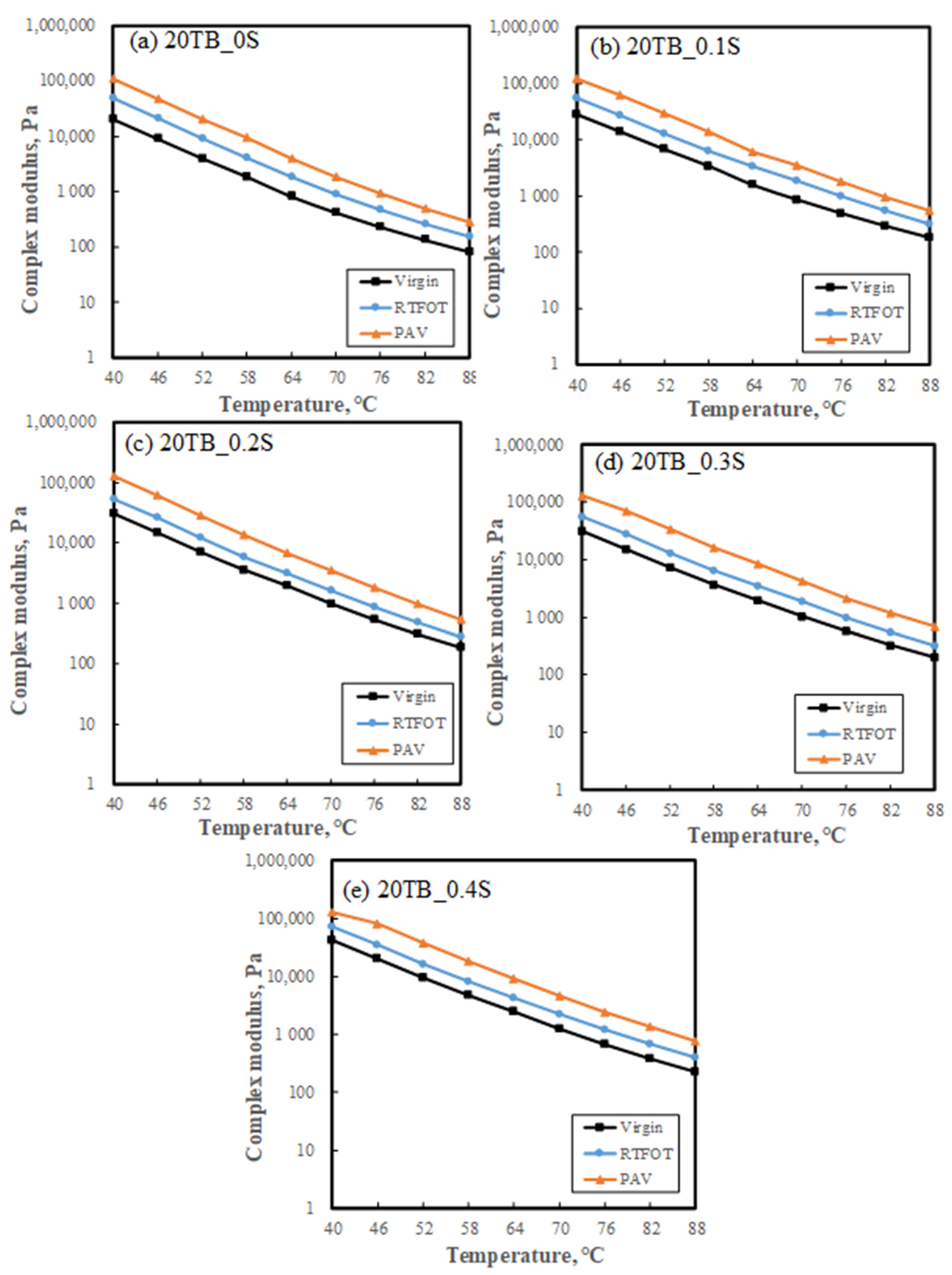
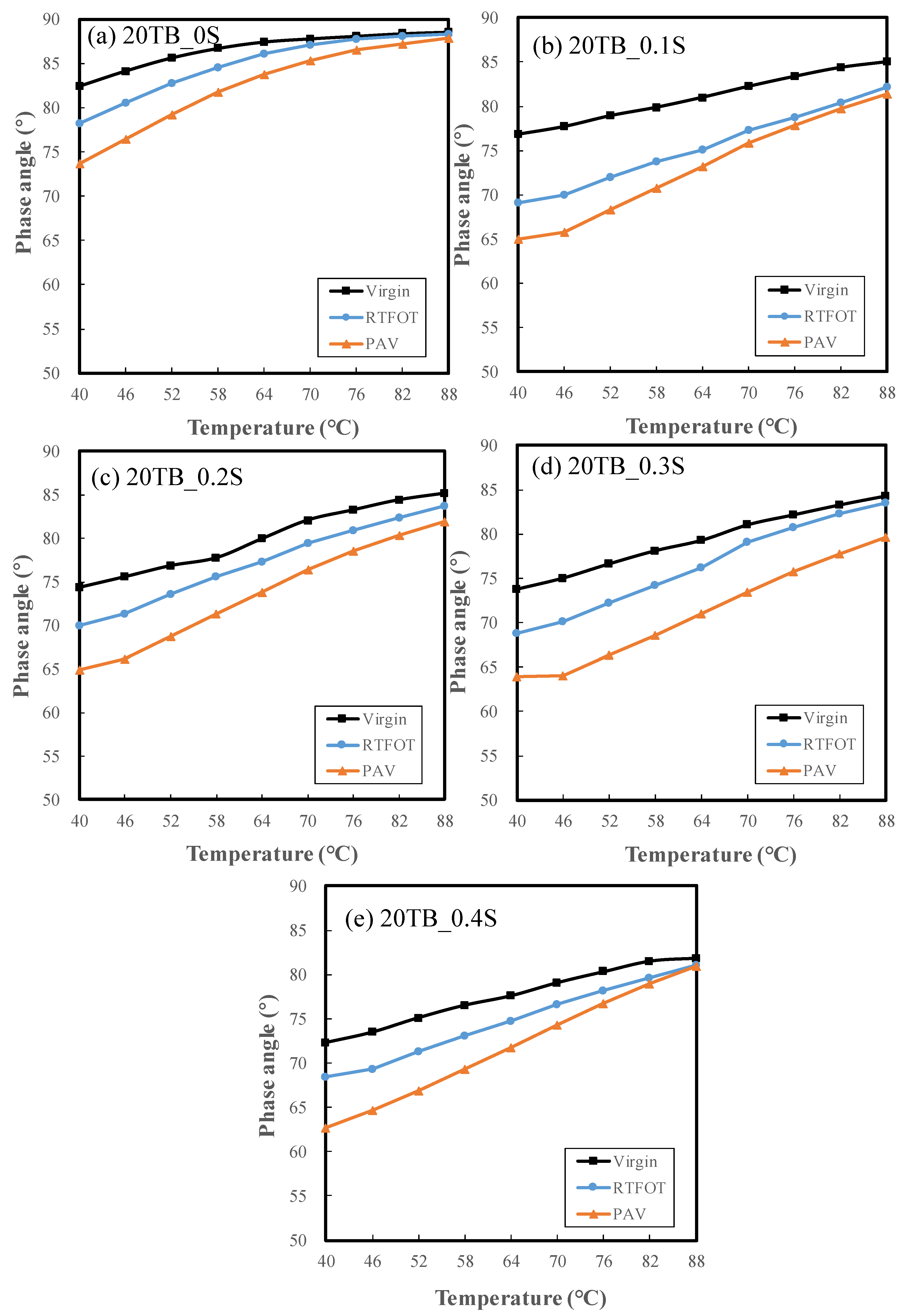
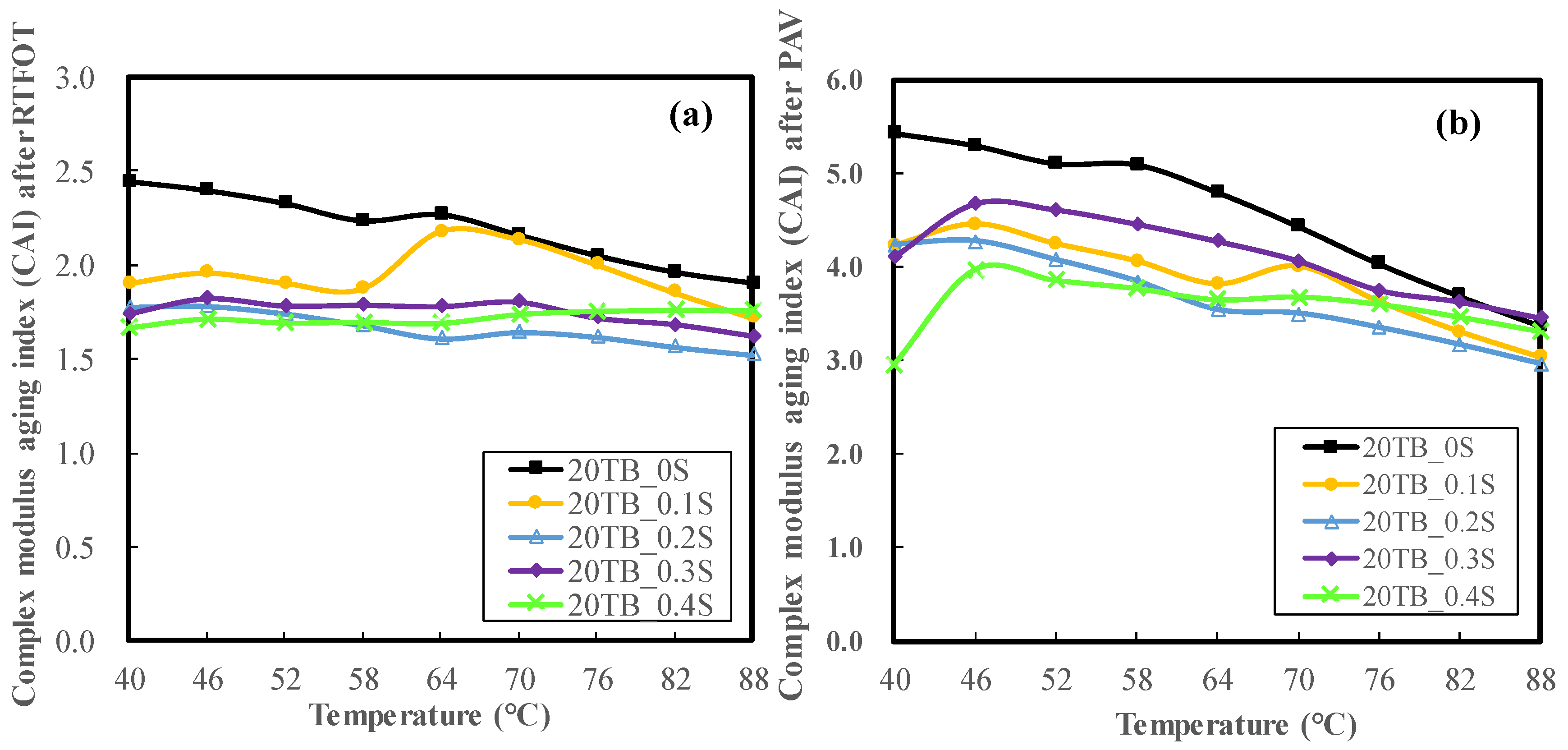
| Sample Name | 20TB_0S |
|---|---|
| Penetration at 25 °C, 0.1 mm | 120 |
| Ductility at 10 °C, cm | 96.4 |
| Softening point, °C | 47.5 |
| Sample | 20TB_0S | 20TB_0.1S | 20TB_0.2S | 20TB_0.3S | 20TB_0.4S | |||||
|---|---|---|---|---|---|---|---|---|---|---|
| ICA (×10−3) | ΔICA (×10−3) | ICA (×10−3) | ΔICA (×10−3) | ICA (×10−3) | ΔICA (×10−3) | ICA (×10−3) | ΔICA (×10−3) | ICA (×10−3) | ΔICA (×10−3) | |
| Unaged | 0.123 | - | 0.000 | - | 0.730 | - | 0.402 | - | 0.454 | - |
| RTFOT aging | 1.536 | 1.412 | 1.362 | 1.362 | 1.242 | 0.512 | 0.788 | 0.386 | 0.774 | 0.320 |
| PAV aging | 6.312 | 6.189 | 5.724 | 5.724 | 4.913 | 4.183 | 3.862 | 3.460 | 4.194 | 3.740 |
| Sample | 20TB_0S | 20TB_0.1S | 20TB_0.2S | 20TB_0.3S | 20TB_0.4S | |||||
|---|---|---|---|---|---|---|---|---|---|---|
| API (×10−3) | ΔAPI (×10−3) | API (×10−3) | ΔAPI (×10−3) | API (×10−3) | ΔAPI (×10−3) | API (×10−3) | ΔAPI (×10−3) | API (×10−3) | ΔAPI (×10−3) | |
| Unaged | 3.309 | - | 3.025 | - | 2.883 | - | 2.872 | - | 2.911 | - |
| RTFOT aging | 2.948 | 0.361 | 2.782 | 0.244 | 2.707 | 0.176 | 2.831 | 0.040 | 2.868 | 0.042 |
| PAV aging | 2.980 | 0.328 | 2.789 | 0.236 | 2.681 | 0.202 | 2.830 | 0.041 | 2.972 | −0.061 |
Publisher’s Note: MDPI stays neutral with regard to jurisdictional claims in published maps and institutional affiliations. |
© 2022 by the authors. Licensee MDPI, Basel, Switzerland. This article is an open access article distributed under the terms and conditions of the Creative Commons Attribution (CC BY) license (https://creativecommons.org/licenses/by/4.0/).
Share and Cite
Wang, S.; Huang, W.; Liu, X.; Lin, P. Aging Characteristics of Rubber Modified Bitumen Mixed with Sulfur after Terminal Blend Process. Sustainability 2022, 14, 2612. https://doi.org/10.3390/su14052612
Wang S, Huang W, Liu X, Lin P. Aging Characteristics of Rubber Modified Bitumen Mixed with Sulfur after Terminal Blend Process. Sustainability. 2022; 14(5):2612. https://doi.org/10.3390/su14052612
Chicago/Turabian StyleWang, Sheng, Weidong Huang, Xueyan Liu, and Peng Lin. 2022. "Aging Characteristics of Rubber Modified Bitumen Mixed with Sulfur after Terminal Blend Process" Sustainability 14, no. 5: 2612. https://doi.org/10.3390/su14052612
APA StyleWang, S., Huang, W., Liu, X., & Lin, P. (2022). Aging Characteristics of Rubber Modified Bitumen Mixed with Sulfur after Terminal Blend Process. Sustainability, 14(5), 2612. https://doi.org/10.3390/su14052612








